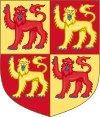The badge has no connection with the native Princes of Wales.
The
Prince of Wales's feathers is the heraldic badge of the Prince
of Wales. It consists of three white ostrich feathers emerging
from a gold coronet. A ribbon below the coronet bears the motto
Ich dien
Its use
is generally traced back to Edward, the Black Prince
(1330–1376), eldest son and heir apparent of Edward III of
England. Edward bore (as an alternative to his differenced royal
arms) a shield of Sable, three ostrich feathers argent,
described as his "shield for peace", this probably means it was
the shield he used for jousting.
According to a longstanding legend, the Black Prince obtained
the badge from the blind King John of Bohemia, against whom he
fought at the Battle of Crécy in 1346 (Welsh
archers (long bowmen) were used in this battle. Before the
fighting began the Welsh archers would show their two fingers -
their two string / arrow fingers - to the enemy to taunt them of
the torrent of pain/death they were about to inflict upon them.
It is thought that this may be where the showing of two fingers
to someone as a form of offence originated).
After the battle, the
prince is said to have gone to the body of the dead king, and
taken his helmet with its ostrich feather crest, afterwards
incorporating the feathers into his arms, and adopting King
John's motto, "Ich
dien",
as his own (Ich Dien being German meaning ‘I Serve’).
The current
English royal family, of course, is of German descent - changing
their surname to 'Windsor' at the outset of the 1st World War
from its original, and true, Bavarian surname of
Saxe-Coburg-Gotha
(Saxe-Coburg-Gotha being a
Duchy consisting of territories within Bavaria).
Historically, the title of ‘Prince of Wales’ has been bestowed
upon the male heir to the English throne thus his emblem, the Prince
of Wales feathers, has mistakenly become associated with Wales.
The
feathers are simply the heraldic badge of an English prince, who
happens to be given the title of Prince of Wales because he is
next in line to the English throne.
The three feathers are NOT Welsh.
There has not been
a Welsh Prince of Wales since circa 1404.
|
Native
Princes of Gwynedd / Wales |
|
Monarch |
Birth
|
Reign |
|
Rhodri
Mawr |
circa
820-878 |
 |
|
Hywel
Dda |
circa 880
- 950 |
|
Grufydd
ap Llywelyn |
circa
1007-1063 |
|
Grufydd
ap Cynan |
circa
1055 - 1137 |
|
Owain
Gwynedd |
circa
1080 |
1137-1170 |
|
Llywelyn Fawr (the Great) - Llywelyn ap Iorwerth |
1173 |
1199-1240 |
|
Dafydd ap
Llywelyn |
1212
|
1240-1246 |
|
Llywelyn Ein Llyw Olaf (the Last) - Llywelyn
ap Gruffydd |
circa
1223 |
1246-1282 |
|
Owain
Glyndwr |
circa
1349 |
1400 - 1404 |
|